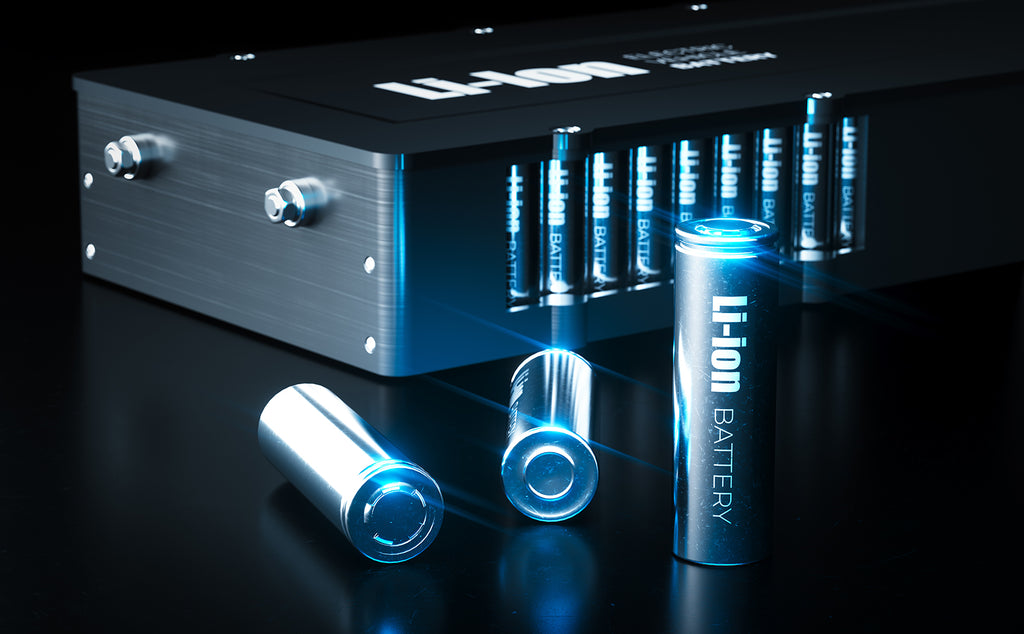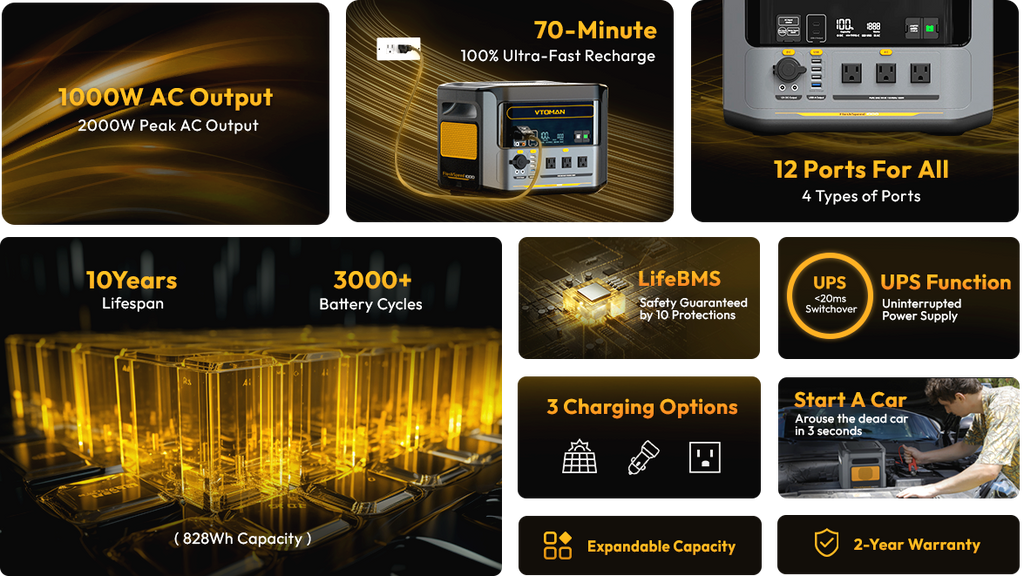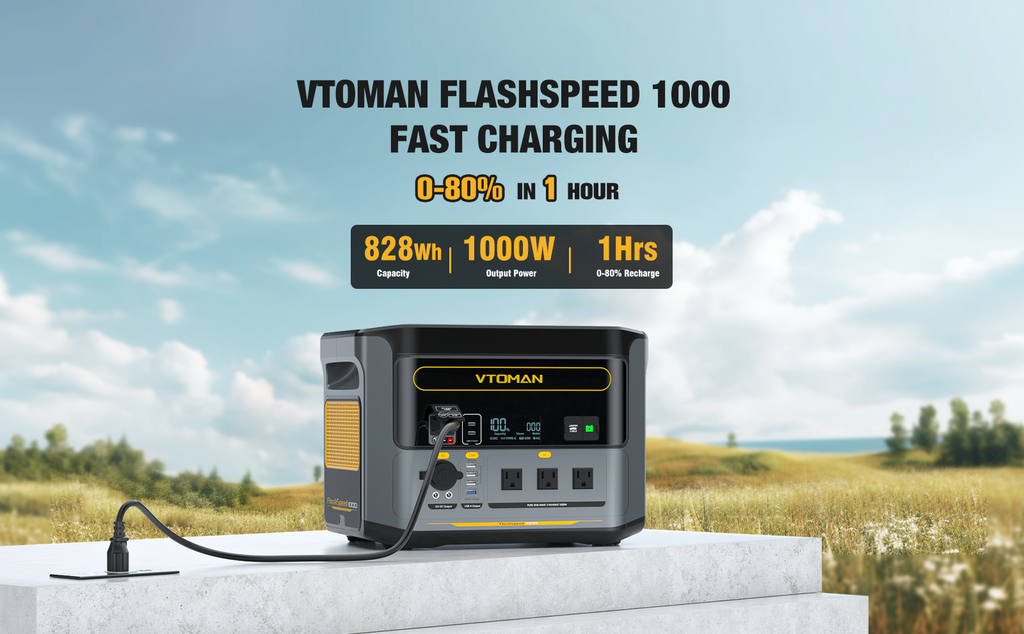In a world increasingly dependent on portable electronics and devices, understanding battery capacity is crucial. This guide aims to clarify two common metrics of battery capacity: milliampere-hours (mAh) and watt-hours (Wh), offering a clear pathway to convert between them. Our journey through this topic not only grounds us in the technicalities but also connects these concepts to real-life applications, particularly in the context of portable power stations:
What Is mAh?
Milliampere-hour, abbreviated as mAh, is a unit that measures electrical power over time. It denotes the amount of electric charge a battery can deliver at a specific current for one hour. For instance, a battery marked with 2000 mAh can supply 2000 milliamperes (2 amperes) of current for one hour before exhaustion. The larger the mAh rating, the longer the battery can power a device before needing a recharge.
What Is Wh?
Watt-hour, shortened to Wh, represents another measure of electrical energy, highlighting the amount of power a battery can deliver over time. One Wh equals the energy delivered by a power flow of one watt for one hour. Thus, a battery with a capacity of 20 Wh can provide 20 watts of power for one hour. Wh offers a more comprehensive understanding of a battery's capacity because it considers both the voltage and the current.
How to Convert mAh to Wh?
Below is a detailed table illustrating the conversion from mAh to Wh at different voltages:
| Battery Capacity (mAh) | Voltage (V) | Energy (Wh) |
|---|---|---|
| 1000 | 3.7 | 3.7 |
| 2000 | 3.7 | 7.4 |
| 3000 | 3.7 | 11.1 |
| 4000 | 3.7 | 14.8 |
| 5000 | 3.7 | 18.5 |
| 1000 | 5 | 5 |
| 2000 | 5 | 10 |
| 3000 | 5 | 15 |
| 4000 | 5 | 20 |
| 5000 | 5 | 25 |
| 1000 | 7.4 | 7.4 |
| 2000 | 7.4 | 14.8 |
| 3000 | 7.4 | 22.2 |
| 4000 | 7.4 | 29.6 |
| 5000 | 7.4 | 37 |
To convert mAh to Wh, you need to understand the relationship between these units and the voltage of the battery. The formula for this conversion is simple:
(mAh × V) / 1000 = Wh
This equation divides the mAh value by 1000 to convert it to ampere-hours (Ah) since there are 1000 milliamperes in an ampere. Multiplying this by the voltage gives you the watt-hours, which accounts for the total energy a battery can deliver.
For example, consider a 5000 mAh battery operating at 5 volts. The conversion to Wh would be:
(5000 × 5) / 1000 = 25 Wh
This means the battery can deliver 25 watt-hours of power under ideal conditions.
How to Convert Wh to mAh?
| Energy (Wh) | Voltage (V) | Battery Capacity (mAh) |
|---|---|---|
| 5 | 3.7 | 1351 |
| 10 | 3.7 | 2703 |
| 15 | 3.7 | 4054 |
| 20 | 3.7 | 5405 |
| 25 | 3.7 | 6757 |
| 5 | 5 | 1000 |
| 10 | 5 | 2000 |
| 15 | 5 | 3000 |
| 20 | 5 | 4000 |
| 25 | 5 | 5000 |
| 5 | 7.4 | 676 |
| 10 | 7.4 | 1351 |
| 15 | 7.4 | 2027 |
| 20 | 7.4 | 2703 |
| 25 | 7.4 | 3378 |
Converting from Wh to mAh involves reversing the earlier process and requires knowing the voltage of the battery. The formula looks like this:
(Wh × 1000) / V = mAh
By dividing the Wh by the voltage, you convert the watt-hours back into ampere-hours, but this time multiply by 1000 to shift from Ah to mAh.
Taking the previous example in reverse, if we have a battery with 25 Wh and a voltage of 5 volts, the conversion to mAh would be:
(25 × 1000) / 5 = 5000 mAh
How Does Voltage Affect the Conversion Between mAh and Wh?
Voltage plays a crucial role as it represents the potential energy between two points. In the conversion between mAh and Wh, voltage determines the actual amount of energy (in Wh) that a battery with a specific capacity (in mAh) can deliver. During conversion, common voltage values used reflect the typical operating voltages of various devices and batteries. For instance:
- 3.7V: This is a common voltage for lithium-ion batteries used in smartphones, tablets, and small electronic devices. The choice of this voltage is due to the chemical properties of lithium-ion cells, which naturally provide this level of electrical potential.
- 5V: This voltage is often used in the conversion for devices like USB-powered gadgets. USB standards, particularly USB 2.0 and USB 3.0, typically output power at 5 volts. This standardization makes 5V a common reference point for portable devices.
- 7.4V or higher: Used for more power-intensive devices like laptops, portable power stations, and certain types of cameras. These devices require more power and thus operate at higher voltages.

The reason specific voltages are essential in the conversion process is that the total energy output (in Wh) of a battery depends not only on how much charge it holds (mAh) but also on how much work (voltage) it can perform per unit of charge. Therefore, when converting from mAh to Wh, using the correct voltage is essential to obtain an accurate measure of the battery's energy content.
Using the wrong voltage in the conversion can result in a significant misrepresentation of the battery's capacity. For example, using a voltage that's too high will overestimate the energy capacity (Wh), while using a voltage that is too low will underestimate it.
The Role of mAh and Wh in a Portable Power Station
In portable power stations, both mAh and Wh are pivotal for determining how long the station can power various devices. mAh gives a quick glance at the storage capacity, while Wh provides a deeper insight into the energy available to meet the power demands of different appliances. Take the Flashspeed 1000.
The FlashSpeed 1000 boasts an actual capacity of 828Wh. This indicates the total amount of energy it can store and deliver to your devices. Translated into practical terms, this high Wh rating means the power station can reliably support a wide range of electronic devices for extended periods, making it an indispensable companion for both daily use and emergency situations.
Key Features of the Flashspeed 1000 Include

| Feature | Description |
|---|---|
| Top LiFePO4 Battery, Super Safety | The FlashSpeed 1000 is equipped with high-quality LiFePO4 batteries coupled with Vtoman's LIFEBMS technology. This ensures exceptional safety and durability, extending the battery's life over 3,000 full cycles while maintaining 80% of its original capacity. |
| Expandable Capacity, Travel Carefree | Initially offering a base capacity of 828Wh, the device can be expanded up to 2376Wh with the addition of a VTOMAN FlashSpeed 1500 Extra Battery. This feature provides a cost-effective solution for users requiring extended power without frequent recharges. |
| V-Beyond | The proprietary V-Beyond technology enables the FlashSpeed 1000 to power devices with up to 2000 watts. It's especially effective for resistive loads including lights, space heaters, toasters, ovens, and coffee makers, enhancing the user experience. |
| Up to 300W Solar Input | The power station features a high-capacity solar input port allowing for efficient recharging up to 300W via solar panels. This feature is environmentally friendly and ensures power availability outdoors or in emergency scenarios where conventional power sources fail. |
| UPS | With a switchover time of less than 20ms, the FlashSpeed 1000's UPS feature is designed to continuously power critical devices like CPAP machines, refrigerators, and computers without interruption during a blackout, ensuring uninterrupted operation. |
Considering these features, the FlashSpeed 1000 is a robust, versatile, and reliable power solution for a range of scenarios. Whether you're an outdoor enthusiast, a professional requiring reliable power for your equipment, or someone seeking an emergency power backup, the FlashSpeed 1000 caters to all your needs with its advanced technology and safety features.

Read More
- VTONews01 Things to consider when buying a portable power station – VTOMAN
- The Versatile Applications of Portable Power Stations – VTOMAN
- Reliable Backup Power to Combat Grid Instability & Blackouts – VTOMAN
- Top 9 New Year's Resolutions for 2024: Live More Sustainably – VTOMAN
- Battery Backup vs. Gas Generator: Which Is Right for You? – VTOMAN












